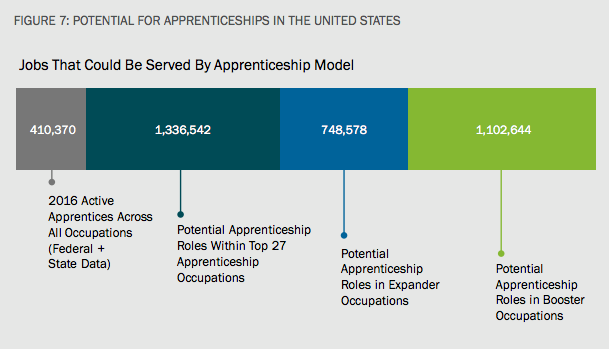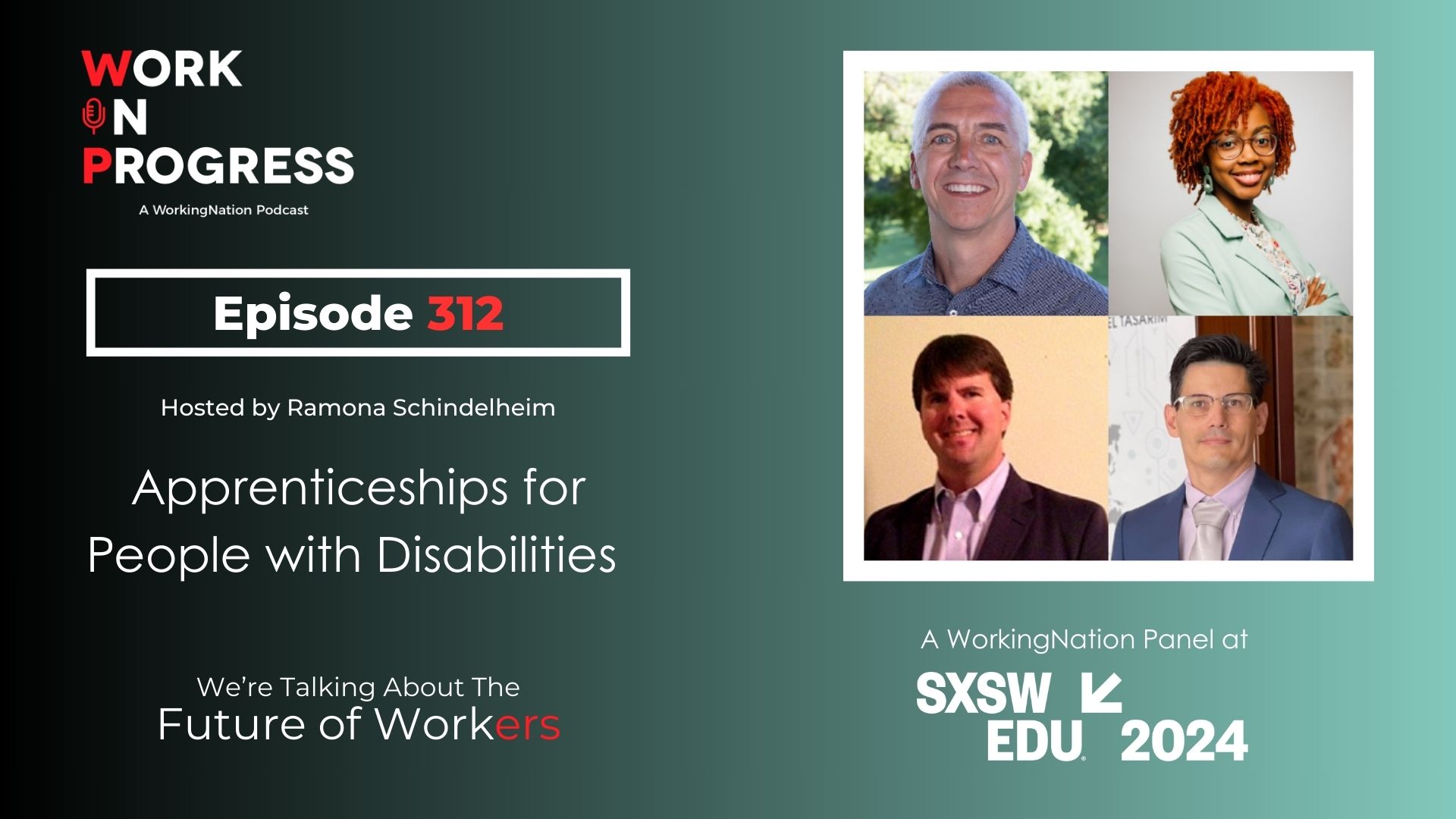As students look for affordable educational pathways to good jobs and employers struggle to locate skilled workers, an apprenticeship can be the ideal place for them to sync up. But the full potential of this training model has yet to be unlocked in the United States.
A new report from the Harvard Business School’s Project on Managing the Future and Burning Glass Technologies suggest apprenticeship training could be applied to more than 70 occupations, almost triple the number of occupations which offer this form of workforce development.
Their analysis of more than 23 million job postings shows that apprenticeships can be more than a pathway to a construction or manufacturing job, they can be applied to jobs like shipping clerk, insurance claims adjuster and tax preparer. These and more middle-skill occupations rely on workers acquiring what the authors say is a “narrow but deep set of skills,” many of which can be learned while on-the-job.
“Apprenticeships lend themselves to jobs with certain types of characteristics,” says report co-author and Professor of Management Practice at Harvard Business School Joseph B. Fuller. “We wanted to think about the scope of jobs that lend themselves to the model.”
Room to Grow: Identifying New Frontiers in Apprenticeship identified the 27 occupations which employ apprentices and found that more than half of them were in construction or extraction — such as mining. These jobs are geared to attract entry-level workers with high school degrees and traditionally have been a way for them to ascend to a secure, middle-class lifestyle.
However, these types of apprenticeships serve a fraction of the overall need for skilled workers. Only 410,000 people were in civilian apprenticeships in 2016, the report said, citing a U.S. Department of Labor statistic. If apprenticeship training in these “core” occupations was widespread, that number would have been more than 1.5 million, according to the study. Going deeper into other occupations that do not employ apprentices, the researchers say that an additional 1.86 million roles can be fulfilled.

In total, the authors found that a potential 3.3 million entry-level occupations which pay a living wage can be accessed through apprenticeships. For high school students who aren’t bound for a four-year university but are looking for something more than a low-skill job, Fuller said that apprenticeships are an ideal setting to get them the skills they need.
“What apprenticeship is good at is taking someone and making them intimately familiar with the important tasks central to getting a job done,” Fuller says. “If you look at the labor force, there’s a very large number of jobs that have those attributes.”
Unlike in Europe, where apprenticeship is common and has been in practice for the past 100 years, most U.S. employers have ignored this model, leaving it clustered in regions with a heavy union presence. Burning Glass Technologies CEO Matt Sigelman says that many employers have been averse to these programs and instead rely on a college degree as a “proxy” for a skilled workforce.
“There’s a free-rider problem when it comes to how employers treat Americans’ educational training infrastructure. They are used to having the right to hire people who have been trained up for [jobs] and not have to pay for that training. There are actually significant costs to the free good that employers are expecting today,” Sigelman says.
RELATED STORY: New study says degree inflation holds back employers and workers
Sigelman refers to the findings in the HBS report, Dismissed by Degrees, which suggests that “degree inflation” is restricting employers’ hiring abilities because they only want college graduates in a tight labor market. The report said that strict requirements in middle-skill occupations cost companies in terms of time and training. And when these jobs are filled by college graduates, there isn’t a guarantee they have the work-ready skills employers need, which dents overall productivity and leads to high turnover.
Fuller, who also co-authored that study, says that this reality will ultimately force employers to “look for alternative pools of talent.” He says that he hopes that these two studies will get employers to consider the true costs of employment and explore their options in educating their future workforce. There has also been a rare bipartisan nudge to employers as both the Obama and Trump administrations have directed millions in federal funding to support apprenticeship training.
RELATED STORY: “The Apprentice” – The White House edition
Fuller says that the federal government has a “major opportunity” to expand apprenticeships further as Congress prepares to debate the reauthorization of the Higher Education Act next year. A first step was taken by House Republicans after they submitted a major overhaul, the PROSPER Act, last week. The act includes grant funding for apprenticeships to be administered by the U.S. Department of Education. The money would be allocated to businesses with public-private workforce development partnerships with educators to subsidize tuition and training materials.
“The federal government spends $120 billion a year on postsecondary education, but those loans and grants can only be used in a highly specified set of institutions,” Fuller says. “Beginning to broaden the definition where a young person can put their loan money or their Pell Grant to work would be a way to tap some innovation.”
Apprenticeships are making a comeback in South Carolina and in Utah. South Carolina gives a tax credit of $1,000 per each apprentice registered in the program and Fuller remarked that apprenticeships in that state have “grown dramatically.” Fuller believes that more effective work can be done at the state and local level as employers, industry associations and educators can link up to create a workforce pipeline that is responsive to industry needs.
“Small incentives encourage people to try something new,” Fuller says.
Sigelman says that starting local “makes a lot of sense,” because it allows for more collaboration between parties with vested interests in growing their economies. For example, the Utah Mechanical Contractors Association responded to its skills gap in construction and manufacturing with the creation of the Utah Career Center and has experienced steady growth in the number of students it has produced.
“For an apprenticeship to work it needs to be more than about training someone for a job at a specific company. It needs to be a token that has currency in the market. You only get currency when you get collaboration across employers. It’s a lot easier to build collaboration at the local level,” Sigelman says.
Although apprenticeships, like in Utah, are still mainly geared toward teaching trade skills, there are innovative solutions taking place which have expanded the model to other occupations mentioned in the report. Harper College in Palatine, Illinois is seeing success in its partnership with Zurich Insurance as they provide students valuable on-the-job experience in a two-year apprenticeship program. Students can earn money while learning how to become insurance claims adjusters, risk assessors and more career paths that comprise the industry.
WorkingNation will feature the program through the story of two apprentices in the next installment of our Do Something Awesome mini-documentary series later this month.
Apprenticeships are beginning to have their day in the sun and this latest report suggests there is much more potential for them to have a lasting impact on training the workforce of the future. Though it’s taken some time for the U.S. to catch on to the value of this model, Fuller says that “the time is right,” to act now to support them.

Join the Conversation: Tell us your ideas about the future of apprenticeships on our Facebook page.











